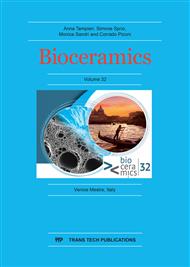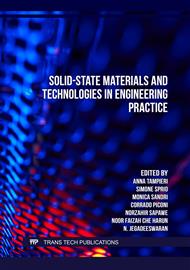p.71
p.83
p.89
p.101
p.107
p.113
p.119
p.131
p.137
In Vivo Evaluation of Calcium-Phosphate Ceramics with Highly-Interconnected Pores Using Porcine Tibia Defect Model
Abstract:
The aim of this study was to compare the difference in bone formation between hydroxyapatite (HAp) and β-tricalcium phosphate (β-TCP) ceramics with similar porous structure. Porous HAp and β-TCP ceramics (total porosity: ~70%) with highly-interconnected structure were fabricated by firing calcium-phosphate fiber mixed with carbon beads (~150 μm). The size of highly-interconnected pores was measured by mercury intrusion technique. Each sample (ϕ4 mm × 8 mm) was implanted into the tibial bone defect (ϕ4.2 mm × 8 mm) of a pig (2 years old, male). After 6 weeks of implantation, undecalcified section was prepared and stained with hematoxylin and eosin (HE) stain. New bone area and remaining material area were evaluated.Interconnection sizes of HAp and β-TCP ceramics were 23.0 µm and 15.6 µm, respectively. New bone area of β-TCP ceramics was significantly higher compared to HAp ceramics. Remaining material ratio was 77.1 ± 3.3% for β-TCP ceramics whereas HAp ceramics remained stable. Bone formation in HAp ceramics was inhomogeneous compared to β-TCP ceramics in HE stained section. Although the β-TCP ceramics interconnection size was smaller, higher resorption may have played a positive role in homogeneous bone formation. According to the result of the study, it is suggested that highly-interconnected porous ceramics made by β-TCP could be a suitable material for bone regeneration.
Info:
Periodical:
Pages:
113-117
Citation:
Online since:
December 2022
Authors:
Price:
Сopyright:
© 2022 Trans Tech Publications Ltd. All Rights Reserved
Share:
Citation:



